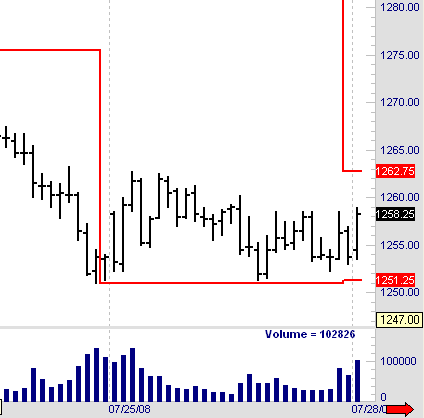Markus' Day Trading Blog
Great Tips For Traders
This morning I received a newsletter from Glen Larson, President of Genesis Financial Technologies. Glen and I have known each other for years, and I always enjoy his insights.
In this issue of his newsletter he had some great tips for traders that I would like to share with you.ÂÂ
Here's what Glen wrote:
The Art Of Growing A Day Trading Account - Part 2
$72,400.
That's the correct answer.
If a trader would be able to consistently make $100 per week per contract, and applied proper money management techniques, then his trading account would grow from $10,000 to $72,400 in only two years.
Here's the spreadsheet:

Too good to be true? Impossible?
For most traders - unfortunately yes.
There's nothing wrong with the logic: Even if a trader would not achieve his goal of making $100 per week and miss it 2-3 weeks in a row, it would simply take a month longer to grow his trading account to $72,400.
The Art Of Growing A Day Trading Account - Part 1
This week I received an email from a trader, who was very unhappy with his trading results:
He has been trading a $10,000 for 6 weeks and made $600 in profits. He was disappointed, because he thought he could make more money with trading. Just as a background: This trader is day trading the e-mini S&P, and he has been trading 1 contract.
$600 in six weeks means that he made $100 per week. That's really not a lot, is it? He could be flipping burgers at McDonald's and make more money, right?
Wrong!
When it comes to day trading, it is all about consistency. This trader is already making a fortune, he just doesn't know it yet. Once he learned how to make consistent profits with day trading consistently - even if it is just $100 per week - he need to apply sound money management strategies and achieve stellar results.
Let me run it down for you:
Day Trading At The Beach - Can It Get Any Better?
There's a lot of hype around day trading. Sneaky vendors make you believe that you can trade whenever you want and whereever you want.
You probably have seen this picture a hundred times: You are sitting somewhere at a beautiful beach and make tons of money with day trading:

Yeah, right!
I just returned from a vacation on the beach. Let me tell you: There's no way that you can actually trade on the beach for the following three reasons:
Will Japan Crush The US Economy?
Today I received an interesting email:
"Hi Markus,
My research indicates that Japan is the single largest investor in US Treasury securities to the tune of some 25% of a foreign holder. In view of the the fact that the invasion of Iran is pending & a possible oil price rise to $250/B ( CEO Gazprom) what is the likelyhood that Japan will call for early redemption?"
My answer: I don't know. I am a technical trader and not a fundamental analyst.
The main difference between a fundamental analyst and a technical analyst is as follows:
The fundamental analysts looks at micro- and macro-economic data to determine whether the price of a financial instruments is overvalued or undervalued. As an example, he might look at the following data when analyzing a stock:
Day Trading and Pivot Points
Tomorrow I am conduction an Open Question-and-Answer Session. I invited 40-50 traders and asked them to submit their questions in advance so that we can use our time tomorrow in the most efficient way.
I received more than 20 questions, and one of the frequently asked question is
"How do I use Pivot Points in my day trading?"
Let's first of all answer the question "What ARE Pivot Points?"
When talking about Pivot Points, most traders refer to the so-called "5-point-system". This system uses the previous day's high (H), low (L) and close (C), along with two support levels (S1 and S2) and two resistance levels (R1 and R2). The pivot points are calculated as follows:
If You Are Day Trading, You Must Watch This Movie
After finishing my blog post yesterday evening I kicked back and watched the movie "21". This is a great movie, and it has some fantastic lessons for day traders.
This movie is inspired by the true story of MIT students who mastered the art of card counting and took Vegas casinos for millions in winnings.
The main character of this movie, Ben Campbell, is looking for a way to pay for tuition into Harvard Med. His brilliant statistic professor, played by Kevin Spacey, reveals a plot in which he and some of the most giftes MIT students try to bust Las Vegas by counting cards at the Blackjack table. After some initial hesitation Ben decides to join the crew.
In a key scene Mickey, the statistic professor, asks Ben: "Are you in?" Ben answers: "Yes, I am in."
Then Mickey looks Ben straight in the eyes and says:
Here's The Dumbest Mistake You Can Make When Day Trading
Unless you are a compulsive gambler, your goal is to make money with day trading. And every day there are people who make money. But the there are even more people, who give the money right back to the market.
Don't make this mistake!
Once you made money, your main goal must become to protect your profits.
Let me give you an example: This morning we received an email from a student who told us that he did two great trades yesterday and made more than $1,000 per contract. He was very happy and wrote: "I'm done trading for the week". However, this morning he was back in our daily live chat, and instead of taking the week off and enjoying the profits he made, he entered the next trade and sure enough: He gave back some of his profits.
Watch These Support and Resistance Levels When Day Trading
In my opinion the two most important support and resistance level for day traders are the previous day high and the previous day low. Just look at the charts of the past three trading days and you see what I mean:

The above chart shows 15min bars of the e-mini S&P. The red lines are the previous day high and low.
Do you see how prices move down to the previous day low on 07-25-2008 and then bounce back?
We saw a similar behavior on 07-23-2008:
Day Trading The Grain Markets - Watch Out For Limit Moves
On August 1, 2006 the agricultural futures started trading side-by-side, and a few months later the volume in the electronic grains surpassed the volume of the pit traded contracts.
The volatility and nice trends attracted many traders, and today day trading the grains is more popular than ever.However, when trading the grains you should keep in mind that these markets "lock limit" when there are strong moves.
A lock limit occurs when the trading price of a futures contract
arrives at the exchanges predetermined limit price. At the lock limit,
trades above or below the lock price are not executed. As a trader you want to avoid these situations, because especially in 2008 there were several days when the grain markets were locked limit. If you are in the wrong side of a trade when the markets are locked, the consequences can be disastrous.
Here's an easy way to calculate the limit level to avoid being trapped in a trade:
What Day Traders Can Learn From Sesame Street
I am getting up at 7:00am in the mornings. While enjoying a coffee I usually join my kids in the living room watching Sesame Street. They LOVE the show, and I am always amazed what stars show up there. This morning they had the Dixie Chicks performing.
Anyways, I am sitting there on the couch with my coffee in my hand and try to wake up. On the TV a kid tried to learn how to skate, but after 2-3 steps it falls down. The kid maintains a positive attitude and says "Practicing tomorrow I'll be better than today".
The next day the kid manages to take 3-4 steps before falling down and says "Practicing tomorrow I'll be better than today."
Will Uncle Sam Eat Your Day Trading Losses?
Today was an exciting day: We hosted a webinar for tax guru Robert Green from www.greentradertax.com. More than 400 trader registered for this event, and Robert delivered an awesome webinar.
(If you missed it, you can request the recording of the webinar here)
Please understand that I am not a tax professional, and you should really consult with Robert to take full advantage of all the wonderful things you can do if you qualify for Trader Tax Status, but there's one thing that really stands out:
The concept of "Net Operating Losses".
A Day Trading Strategy With A 90% Winning Percentage?
Today I received an email:
Hi Markus,
I bought your "The Complete Guide To Day Trading" book. In your book you said you have a setup that produce 90% winning trades. What is your setup for day trading?
It seems that this reader misunderstood what I wanted to say. I used this as an example for a highly curve-fitted trading strategy that will fail in real trading.
Here's what I say in the book:
Subscribe Now!
Recent Day Trading Articles
- Do we measure our success rates at different times of the day?
- Why You MUST Stay In Contact With Other Traders
- The Power Of Weekly Profit Goals In Day Trading
- How Many Markets Should You Trade?
- Let Your Profits Run...
- Our Live Day Trading Webinar - A Complete Disaster?
- Finding Trends And Trading Them
- The Sky Is Falling - Time To Panic, Or Is It?
- The $700 Billion Bailout Plan - A Good Idea?
- "Does The SEC Ban On Short-Selling Stocks Affect Your Day Trading?"

